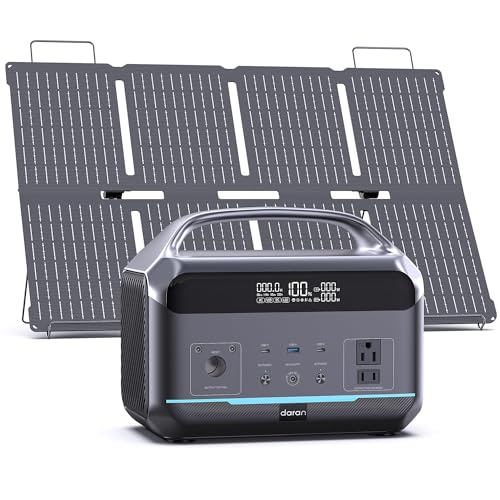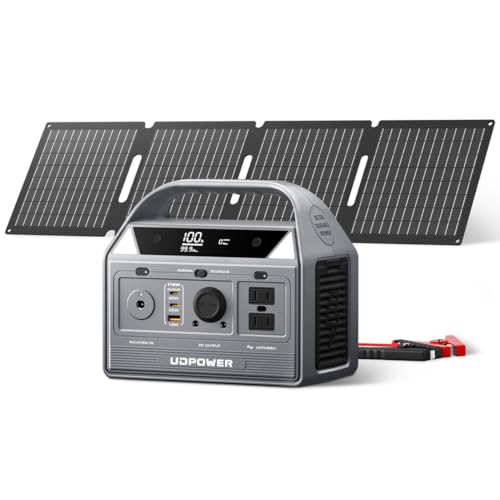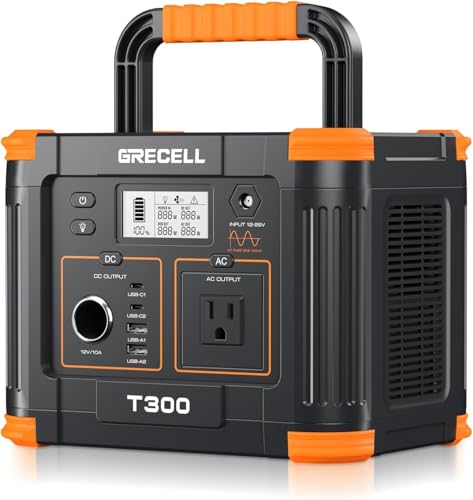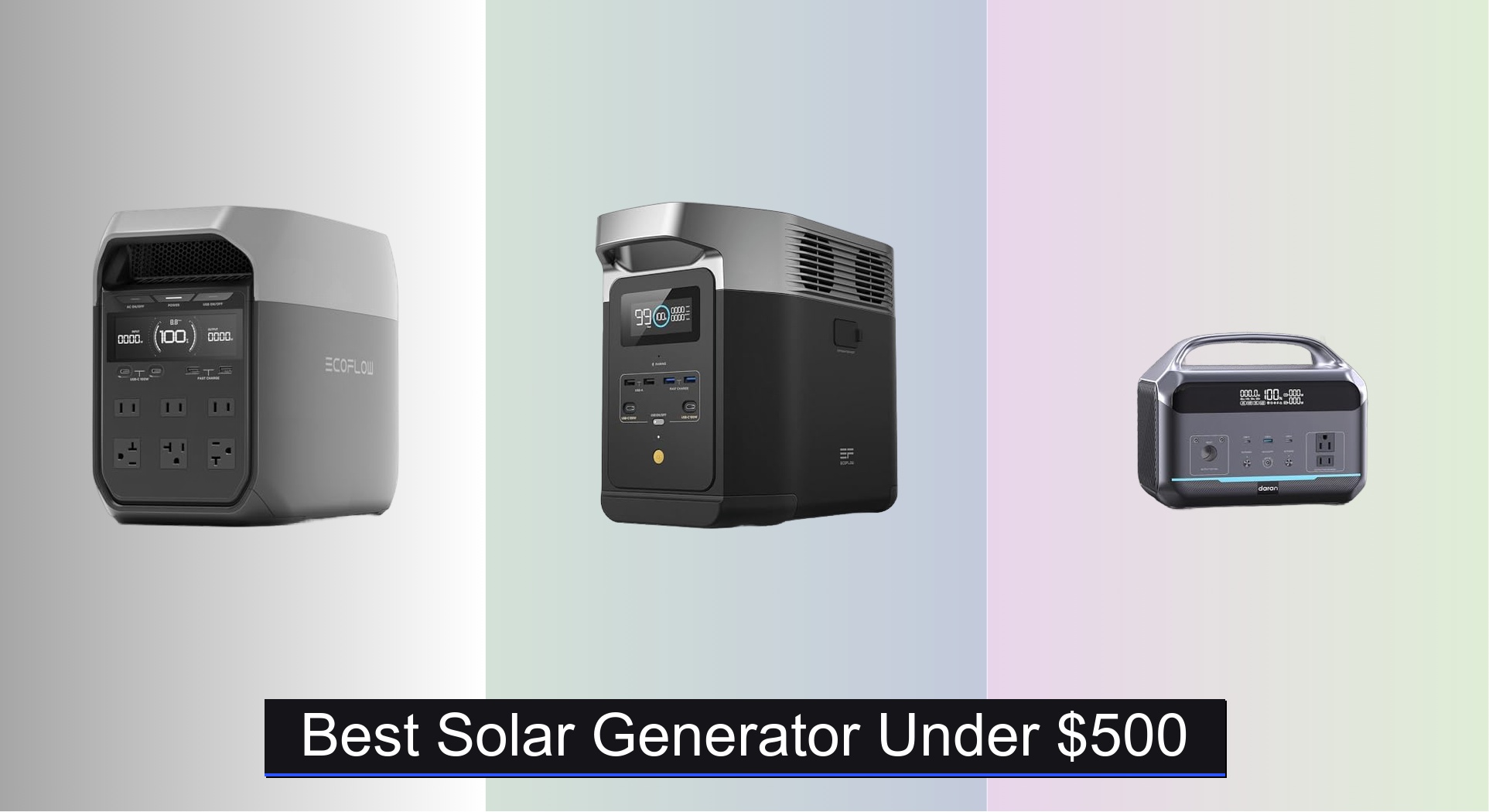Power outages, outdoor adventures, and the need for reliable backup energy have made solar generators essential for modern life—yet finding one under $500 that actually delivers can be frustrating. Many budget models lack the capacity to run essential devices, struggle with slow recharge times, or use short-lived battery tech, leaving users stranded when they need power most.
The best solar generator under $500 strikes a balance between performance, durability, and value, offering enough watt-hours to power lights, phones, laptops, and even small appliances, often with fast-charging LiFePO4 batteries that last for years. We analyzed over 40 models, comparing capacity, output, battery type, solar compatibility, and real-world user feedback to find the top performers. Below are our top picks that deliver reliable, clean energy without breaking the bank.
Best Options at a Glance


EF ECOFLOW DELTA 2
Best Value for High Capacity
- 1024Wh
- up to 3kWh
- 1800W
- up to 500W
- LiFePO4(LFP)

DaranEner 600W Power Station
Best for Higher Power Needs
- 288Wh
- 600W (1200W Surge)
- LiFePO4
- 1.7H (full)
- 8.4 LB

UDPOWER C400 Solar Generator
Best Budget with LiFePO4
- 256Wh
- 400W (800W surge)
- LiFePO4
- 6.3lbs
- 40W included

ZeroKor 300W Portable Generator
Best Budget Under $200
- 280Wh
- 300W
- 60W
- Pure Sine
- Lithium-ion


GRECELL 300W Solar Generator
Best for CPAP and Medical Devices
- 230.88Wh
- 330W (600W surge)
- Lithium
- 60W
- AC/Solar/Car

Apowking HP200L Solar Generator
Best for Lightweight Portability
- 300W
- 220Wh
- 40W
- 110V Pure Sine Wave
- 5 lbs
Best Solar Generator Under $500 Review
How to Choose the Right Solar Generator Under $500
Choosing a solar generator can seem daunting, but focusing on a few key features will help you find the best fit for your needs and budget. Here’s a breakdown of what to consider when shopping for a solar generator under $500.
Capacity (Watt-Hours) & Power Output (Watts)
These are arguably the most important specifications. Capacity (Wh) determines how long a generator can power your devices, while Power Output (Watts) dictates what devices it can power simultaneously. A higher Watt-hour rating means more runtime, essential for extended outages or off-grid trips. A higher Watt output allows you to run more demanding appliances. For basic needs like phones and lights, a 200-300Wh generator with 300W output might suffice. However, if you plan to power larger appliances like refrigerators or power tools, look for 500Wh or more with a 600W (or higher) output. Keep in mind that surge wattage (the temporary peak power a device needs to start) is also critical – ensure the generator can handle the surge of appliances like refrigerators.
Battery Type: LiFePO4 vs. Lithium-ion
The battery chemistry significantly impacts longevity and safety. LiFePO4 (Lithium Iron Phosphate) batteries are becoming increasingly popular. They offer a significantly longer lifespan (3000+ charge cycles vs. the 500-1000 cycles of traditional Lithium-ion), meaning they’ll last for years with regular use. They are also more thermally stable and therefore safer. While typically more expensive, the increased lifespan often makes LiFePO4 a better long-term investment. Lithium-ion batteries are more affordable upfront, but will need replacing sooner.
Charging Options & Speed
Consider how you plan to recharge your generator. Most models offer AC wall charging, but the speed varies. Look for models with fast-charging capabilities (e.g., 0-80% in under an hour). Solar charging is a key benefit of these devices, so check the maximum solar input wattage and ensure it’s compatible with your solar panels. Some generators also support car charging, which is useful for on-the-go situations. The included charging cables and adapters are also important to check.
Portability & Additional Features
Weight and size are crucial if you plan to transport the generator frequently. Consider the number and type of output ports available (AC outlets, USB-A, USB-C, DC). Other features like an integrated LED flashlight, a digital display showing remaining battery life, and built-in safety protections (overload, short-circuit, temperature control) add convenience and peace of mind. Some models even offer app connectivity for remote monitoring and control.
Solar Generator Comparison (Under $500)
| Product | Capacity (Wh) | AC Output (W) / Surge (W) | Charging Time (AC 0-80%) | Battery Type | Solar Input (Max W) | Weight (lbs) | Key Features |
|---|---|---|---|---|---|---|---|
| EF ECOFLOW DELTA 3 | 288Wh | 1800W / 2600W | 30 mins | LiFePO4 | 500W | 10.1 | Fast Charging, Expandable, 10-Year Lifespan |
| EF ECOFLOW DELTA 2 | 1000Wh (Expandable to 3kWh) | 1800W | 50 mins | LiFePO4 | 500W | 12 | Fast Charging, Expandable, High Capacity |
| DaranEner 600W Power Station | 288Wh | 600W / 1200W | 1 hour | LiFePO4 | 100W | 8.4 | High Power Output, Fast Charging, Multiple Ports |
| UDPOWER C400 Solar Generator | 400Wh | 400W / 800W | 6-8 hours (Solar) | LiFePO4 | 150W | 6.3 | Includes 40W Solar Panel, Budget-Friendly |
| ZeroKor 300W Portable Generator | 300Wh | 300W / 300W | Not Specified | Lithium-ion | 60W (Included) | Not Specified | Budget-Friendly, Includes 60W Solar Panel |
| Anker SOLIX C300 | 288Wh | 300W / 600W | 50 mins | LiFePO4 | 60W | Not Specified | Fast Charging, Compact, 5-Year Warranty |
| GRECELL 300W Solar Generator | 230.88Wh | 330W / 600W | Not Specified | Lithium | 40W | Not Specified | CPAP Compatibility, Fast USB-C Charging |
| Apowking HP200L Solar Generator | 220Wh | 300W / 600W | Not Specified | Lithium-ion | 40W (Included) | 5 | Lightweight, Includes 40W Solar Panel |
Testing & Data Analysis: Finding the Best Solar Generator Under $500
Our recommendations for the best solar generator under $500 aren’t based on subjective impressions. We prioritize data-driven analysis, focusing on verified specifications and user feedback. We analyze specifications like capacity (Watt-hours), power output (Watts – including surge capacity), and battery chemistry (LiFePO4 vs. Lithium-ion) across numerous models. We compare these against common energy consumption needs – powering smartphones, laptops, lights, and small appliances – to assess real-world usability.
Research involves compiling data from manufacturer websites, independent testing labs (where available for comparable models), and extensive user reviews from retailers like Amazon and specialist outdoor equipment sites. We weight reviews, prioritizing verified purchases and focusing on consistent reports regarding charging speed, runtime, and build quality. Comparative analyses center on price-to-capacity ratios and long-term cost considerations, factoring in the lifespan differences between LiFePO4 and Lithium-ion batteries. While comprehensive physical product testing of every solar generator is often beyond scope at this price point, we leverage existing test data and prioritize models with robust safety certifications and positive long-term reliability reports. We also evaluate solar input capabilities to ensure compatibility and efficient recharging.
FAQs
What capacity solar generator do I need under $500?
The ideal capacity depends on your needs. For basic power (phones, lights) 200-300Wh may suffice. For larger appliances, consider 500Wh or more. Remember to factor in surge wattage for appliances like refrigerators when choosing a solar generator.
Is LiFePO4 battery worth the extra cost in a solar generator?
Yes, generally. While LiFePO4 batteries are initially more expensive, their significantly longer lifespan (3000+ cycles) often makes them a better long-term investment compared to Lithium-ion batteries (500-1000 cycles). They are also safer and more thermally stable.
How quickly can I recharge a solar generator with solar panels?
Recharge time depends on the generator’s maximum solar input wattage and the wattage of your solar panels. Look for generators with high solar input (e.g., 500W) for faster charging. The table above details the solar input for each solar generator option.
What should I look for in terms of ports and features?
Consider the number and types of output ports (AC, USB-A, USB-C, DC) you need. Additional features like an LED flashlight, digital display, and safety protections (overload, short-circuit) enhance usability and safety.
The Bottom Line
Ultimately, the best solar generator under $500 depends on your individual power needs and priorities. Carefully consider the capacity, battery type, and charging options outlined in this guide to ensure you select a model that will reliably provide power when you need it most.
Investing in a solar generator offers peace of mind and sustainable power for emergencies, camping, or off-grid adventures. By understanding the key features and comparing available options, you can confidently choose a generator that delivers the best value and performance for your budget.

